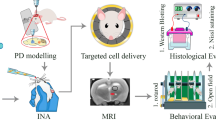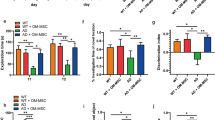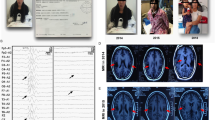Abstract
Finding a simple and effective way for transferring cells to the brain lesion site with minimum side effects mounts a challenge in cell therapy. Cell delivery via nasal route using the bypassing the blood-brain barrier (BBB) property is a simple and non-invasive strategy without serious complications such as trauma. Therefore, it is a suitable technique to treat neurodegenerative disorders like Parkinson’s disease (PD). Olfactory ectomesenchymal stem cells (OE-MSCs) located in the lamina propria of olfactory mucosa could be differentiated into dopaminergic neurons under in vitro and in vivo conditions. Thus, OE-MSCs represent a good source of Parkinson’s stem cell–based therapy. In this research, we studied thirty male rats (n = 10 in each group) in three control (Ctl), lesion (LE), and intranasal administration (INA) groups to investigate the therapeutic effect of intranasal injection of OE-MSCs in the Parkinson’s animal models. To do so, we examined the homing variation of OE-MSCs in different brain regions such as olfactory bulb (OB), cortex, striatum (Str), hippocampus (HPC), and substantia nigra (SN). The results of real-time PCR and immunohistochemistry (IHC) analysis showed the expression of dopaminergic neuron markers such as PITX3, PAX2, PAX5 (as dopaminergic neurons markers), tyrosine hydroxylase (TH), and dopamine transporter (DAT) 2 months after INA of 1 × 106 OE-MSCs. The results confirmed that IN OE-MSCs delivery into the central nervous system (CNS) was powerful enough to improve the behavioral functions in the animal models of PD.
Graphical Abstract






Similar content being viewed by others
Data Availability
We would like to declare that data supporting the study findings can be provided within the paper or supplementary materials.
References
Abedi P, Delaville C, De Deurwaerdere P, Benjelloun W, Benazzouz A (2013) Intrapallidal administration of 6-hydroxydopamine mimics in large part the electrophysiological and behavioral consequences of major dopamine depletion in the rat. Neuroscience 236:289–297
Akbari A, Amanpour S, Muhammadnejad S, Ghahremani MH, Ghaffari SH, Dehpour AR, Mobini GR, Shidfar F, Abastabar M, Khoshzaban A (2014) Evaluation of antitumor activity of a TGF-beta receptor I inhibitor (SD-208) on human colon adenocarcinoma. DARU J Pharm Sci 22(1):47
Alizadeh R, Bagher Z, Kamrava SK, Falah M, Hamidabadi HG, Boroujeni ME, Mohammadi F, Khodaverdi S, Zare-Sadeghi A, Olya A (2019a) Differentiation of human mesenchymal stem cells (MSC) to dopaminergic neurons: a comparison between Wharton’s jelly and olfactory mucosa as sources of MSCs. J Chem Neuroanat 96:126–133
Alizadeh R, Kamrava SK, Bagher Z, Farhadi M, Falah M, Moradi F, Boroujeni ME, Soleimani M, Kamyab A, Komeili A (2019b) Human olfactory stem cells: as a promising source of dopaminergic neuron-like cells for treatment of Parkinson's disease. Neurosci Lett 696:52–59
Alizadeh R, Ramezanpour F, Mohammadi A, Eftekharzadeh M, Simorgh S, Kazemiha M, Moradi F (2019c) Differentiation of human olfactory system-derived stem cells into dopaminergic neuron-like cells: a comparison between olfactory bulb and mucosa as two sources of stem cells. J Cell Biochem 120(12):19712–19720
Balyasnikova IV, Prasol MS, Ferguson SD, Han Y, Ahmed AU, Gutova M, Tobias AL, Mustafi D, Rincón E, Zhang L (2014) Intranasal delivery of mesenchymal stem cells significantly extends survival of irradiated mice with experimental brain tumors. Mol Ther 22(1):140–148
Banfi A, Bianchi G, Notaro R, Luzzatto L, Cancedda R, Quarto R (2002) Replicative aging and gene expression in long-term cultures of human bone marrow stromal cells. Tissue Eng 8(6):901–910
Björklund LM, Sánchez-Pernaute R, Chung S, Andersson T, Chen IYC, McNaught KSP, Brownell A-L, Jenkins BG, Wahlestedt C, Kim K-S (2002) Embryonic stem cells develop into functional dopaminergic neurons after transplantation in a Parkinson rat model. Proc Natl Acad Sci 99(4):2344–2349
Brown AB, Yang W, Schmidt NO, Carroll R, Leishear KK, Rainov NG, Black PM, Breakefield XO, Aboody KS (2003) Intravascular delivery of neural stem cell lines to target intracranial and extracranial tumors of neural and non-neural origin. Hum Gene Ther 14(18):1777–1785
Caplan H, Olson SD, Kumar A, George M, Prabhakara KS, Wenzel P, Bedi S, Toledano-Furman NE, Triolo F, Kamhieh-Milz J (2019) Mesenchymal stromal cell therapeutic delivery: translational challenges to clinical application. Front Immunol 10
Cenci MA, Lundblad M (2007) Ratings of L-DOPA-induced dyskinesia in the unilateral 6-OHDA lesion model of Parkinson's disease in rats and mice. Curr Protoc Neurosci 41(1):9.25. 21–29.25. 23
Chapman CD, Frey WH, Craft S, Danielyan L, Hallschmid M, Schiöth HB, Benedict C (2013) Intranasal treatment of central nervous system dysfunction in humans. Pharm Res 30(10):2475–2484
Coles JA, Myburgh E, Brewer JM, McMenamin PG (2017) Where are we? The anatomy of the murine cortical meninges revisited for intravital imaging, immunology, and clearance of waste from the brain. Prog Neurobiol 156:107–148
Danielyan L, Schäfer R, von Ameln-Mayerhofer A, Buadze M, Geisler J, Klopfer T, Burkhardt U, Proksch B, Verleysdonk S, Ayturan M (2009) Intranasal delivery of cells to the brain. Eur J Cell Biol 88(6):315–324
Danielyan L, Schäfer R, von Ameln-Mayerhofer A, Bernhard F, Verleysdonk S, Buadze M, Lourhmati A, Klopfer T, Schaumann F, Schmid B (2011) Therapeutic efficacy of intranasally delivered mesenchymal stem cells in a rat model of Parkinson disease. Rejuvenation Res 14(1):3–16
Delorme B, Nivet E, Gaillard J, Häupl T, Ringe J, Devèze A, Magnan J, Sohier J, Khrestchatisky M, Roman FS (2009) The human nose harbors a niche of olfactory ectomesenchymal stem cells displaying neurogenic and osteogenic properties. Stem Cells Dev 19(6):853–866
Feng Z, Gao F (2012) Stem cell challenges in the treatment of neurodegenerative disease. CNS Neurosci Ther 18(2):142–148
Galeano C, Qiu Z, Mishra A, Farnsworth SL, Hemmi JJ, Moreira A, Edenhoffer P, Hornsby PJ (2018) The route by which intranasally delivered stem cells enter the central nervous system. Cell Transplant 27(3):501–514
Ge L, Jiang M, Duan D, Wang Z, Qi L, Teng X, Zhao Z, Wang L, Zhuo Y, Chen P (2016) Secretome of olfactory mucosa mesenchymal stem cell, a multiple potential stem cell. Stem Cells Int 2016
Günes C, Rudolph KL (2013) The role of telomeres in stem cells and cancer. Cell 152(3):390–393
Hanson LR, Fine JM, Svitak AL, Faltesek KA (2013) Intranasal administration of CNS therapeutics to awake mice. JoVE (Journal of Visualized Experiments) 74:e4440
Hargus G, Cooper O, Deleidi M, Levy A, Lee K, Marlow E, Yow A, Soldner F, Hockemeyer D, Hallett PJ (2010) Differentiated Parkinson patient-derived induced pluripotent stem cells grow in the adult rodent brain and reduce motor asymmetry in Parkinsonian rats. Proc Natl Acad Sci 107(36):15921–15926
Hicks A, Jolkkonen J (2009) Challenges and possibilities of intravascular cell therapy in stroke. Acta Neurobiol Exp (Wars) 69(1):1–11
Hornykiewicz O (2006) The discovery of dopamine deficiency in the parkinsonian brain. Parkinson’s disease and related disorders, Springer: 9-15.
Kim SU, De Vellis J (2009) Stem cell-based cell therapy in neurological diseases: a review. J Neurosci Res 87(10):2183–2200
Kitada M, Dezawa M (2012) Parkinson's disease and mesenchymal stem cells: potential for cell-based therapy. Parkinson’s Dis 2012
Lindvall O, Kokaia Z (2009) Prospects of stem cell therapy for replacing dopamine neurons in Parkinson's disease. Trends Pharmacol Sci 30(5):260–267
Lindvall O, Kokaia Z, Martinez-Serrano A (2004) Stem cell therapy for human neurodegenerative disorders–how to make it work. Nat Med 10(7s):S42–S50
Namjoo Z, Mortezaee K, Joghataei MT, Moradi F, Piryaei A, Abbasi Y, Hosseini A, Majidpoor J (2018) Targeting axonal degeneration and demyelination using combination administration of 17β-estradiol and Schwann cells in the rat model of spinal cord injury. J Cell Biochem 119(12):10195–10203
Nasiri E, Alizadeh A, Roushandeh AM, Gazor R, Hashemi-Firouzi N, Golipoor Z (2019) Melatonin-pretreated adipose-derived mesenchymal stem cells efficeintly improved learning, memory, and cognition in an animal model of Alzheimer's disease. Metab Brain Dis:1–13
Pendharkar AV, Chua JY, Andres RH, Wang N, Gaeta X, Wang H, De A, Choi R, Chen S, Rutt BK (2010) Biodistribution of neural stem cells after intravascular therapy for hypoxic–ischemia. Stroke 41(9):2064–2070
Politis M, Lindvall O (2012) Clinical application of stem cell therapy in Parkinson's disease. BMC Med 10(1):1
Rui K, Zhang Z, Tian J, Lin X, Wang X, Ma J, Tang X, Xu H, Lu L, Wang S (2016) Olfactory ecto-mesenchymal stem cells possess immunoregulatory function and suppress autoimmune arthritis. Cell Mol Immunol 13(3):401–408
Salama M, Sobh M, Emam M, Abdalla A, Sabry D, El-Gamal M, Lotfy A, El-Husseiny M, Sobh M, Shalash A (2017) Effect of intranasal stem cell administration on the nigrostriatal system in a mouse model of Parkinson's disease. Exp Ther Med 13(3):976–982
Simorgh S, Alizadeh R, Eftekharzadeh M, Haramshahi SMA, Milan PB, Doshmanziari M, Ramezanpour F, Gholipourmalekabadi M, Seifi M, Moradi F (2019) Olfactory mucosa stem cells: an available candidate for the treatment of the Parkinson's disease. J Cell Physiol 234(12):23763–23773
Tysnes O-B, Storstein A (2017) Epidemiology of Parkinson’s disease. J Neural Transm 124(8):901–905
Wernig M, Zhao J-P, Pruszak J, Hedlund E, Fu D, Soldner F, Broccoli V, Constantine-Paton M, Isacson O, Jaenisch R (2008) Neurons derived from reprogrammed fibroblasts functionally integrate into the fetal brain and improve symptoms of rats with Parkinson's disease. Proc Natl Acad Sci 105(15):5856–5861
Yang B, Migliati E, Parsha K, Schaar K, Xi X, Aronowski J, Savitz SI (2013) Intra-arterial delivery is not superior to intravenous delivery of autologous bone marrow mononuclear cells in acute ischemic stroke. Stroke 44(12):3463–3472
Yasuhara T, Matsukawa N, Hara K, Yu G, Xu L, Maki M, Kim SU, Borlongan CV (2006) Transplantation of human neural stem cells exerts neuroprotection in a rat model of Parkinson's disease. J Neurosci 26(48):12497–12511
Youdim MB, Buccafusco JJ (2005) Multi-functional drugs for various CNS targets in the treatment of neurodegenerative disorders. Trends Pharmacol Sci 26(1):27–35
Zhang K, Gao J, Zhang Z (2015) Evaluation of Parkinson’s disease in 3 rat models induced by three different unilateral injections of 6-hydroxydopamine. J Pharm Biomed Sci 5(11)
Acknowledgments
This work was funded by Iran University of Medical Sciences [grant no. 29348]. The authors would like to thank Dr. Kamran Kamrava and Dr. Maryam Jalessi from ENT and Head and Neck Research Center in Hazrat Rasoul Akram Hospital for their support of this paper.
Author information
Authors and Affiliations
Contributions
Rafieh Alizadeh and Fatemeh Moradi were contributed to the conception and design stages of the study. The isolation and preparation of OE-MSCs were performed by Sara Simorgh and Fariba Karimzadeh. The flow cytometry analysis was conducted by Elham Seidkhani. The first draft of the paper was written by Sara Simorgh and Hamidreza Kasbiyan, and then read and revised by all the authors. Moreover, the final version of the manuscript was confirmed by all the authors prior to the submission.
Corresponding authors
Ethics declarations
The study protocols have been approved by the ethical committee of Iran University of Medical Sciences (ethical code: IR.IUMS.REC1395.95-03-30-29348).
Conflict of Interest
The authors declare that they have no conflict of interest.
Additional information
Publisher’s Note
Springer Nature remains neutral with regard to jurisdictional claims in published maps and institutional affiliations.
Electronic supplementary material
ESM 1
(DOCX 858 kb)
Rights and permissions
About this article
Cite this article
Simorgh, S., Alizadeh, R., Shabani, R. et al. Olfactory mucosa stem cells delivery via nasal route: a simple way for the treatment of Parkinson disease. Neurotox Res 39, 598–608 (2021). https://doi.org/10.1007/s12640-020-00290-1
Received:
Revised:
Accepted:
Published:
Issue Date:
DOI: https://doi.org/10.1007/s12640-020-00290-1




